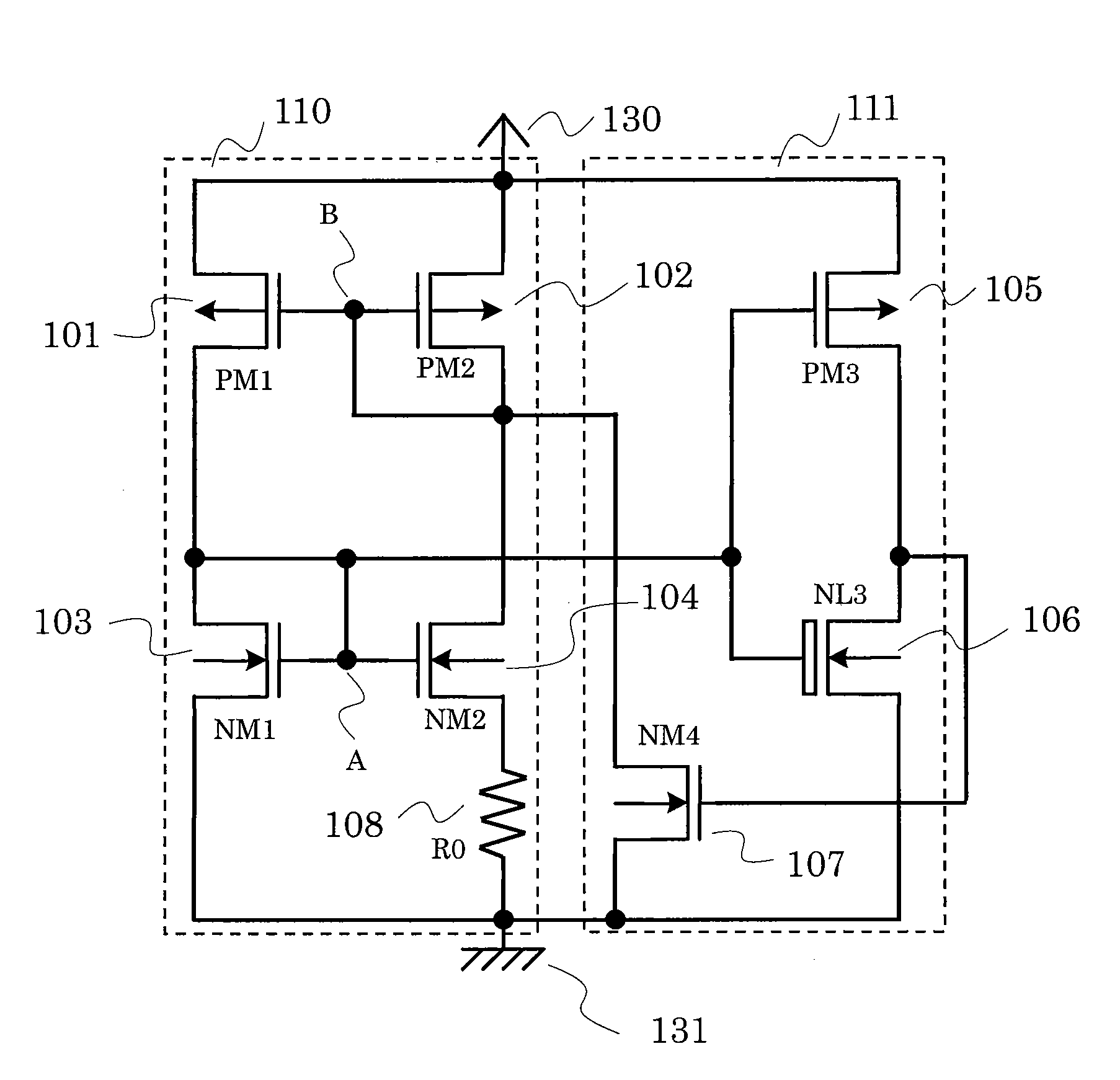Constant current circuit start-up circuitry for preventing power input oscillation
a technology of constant current circuit and start-up circuit, which is applied in the direction of electric variable regulation, process and machine control, instruments, etc., can solve the problems of not being suitable for lower current consumption, and achieve the effect of reliable start-up of constant current circuit in a short period of time and low current consumption operation
- Summary
- Abstract
- Description
- Claims
- Application Information
AI Technical Summary
Benefits of technology
Problems solved by technology
Method used
Image
Examples
first embodiment
[0025]FIG. 1 is a circuit diagram of a constant current circuit according to a first embodiment of the present invention.
[0026]The constant current circuit according to the first embodiment includes a constant current circuit section 110 and a start-up circuit section 111.
[0027]The constant current circuit section 110 includes a P-channel transistor 101, a P-channel transistor 102, an N-channel transistor 103, an N-channel transistor 104, and a resistor 108. The P-channel transistor 101 has a source connected to a power supply terminal 130, a drain connected to a drain of the N-channel transistor 103, and a gate connected to a gate of the P-channel transistor 102. The P-channel transistor 102 has a source connected to the power supply terminal 130, and a drain connected to its own gate and a drain of the N-channel transistor 104. The N-channel transistor 103 has a source connected to a ground terminal 131, and the drain connected to its own gate and a gate of the N-channel transisto...
second embodiment
[0037]FIG. 2 is a circuit diagram of a constant current circuit according to a second embodiment of the present invention.
[0038]FIG. 2 is different from FIG. 1 in that a resistor 202 is interposed between an N-channel transistor 201 and the P-channel transistor 105, and that the N-channel transistor 201 has the same threshold as the N-channel transistor 103 and the N-channel transistor 104.
[0039]The resistor 202 has one end connected to the drain of the P-channel transistor 105 and another end connected to a drain of the N-channel transistor 201 and the gate of the N-channel transistor 107.
[0040]Next, an operation of the constant current circuit according to the second embodiment is described.
[0041]Even in a case where the N-channel transistor 201 cannot employ a transistor different in threshold from the N-channel transistor 103 and the N-channel transistor 104 due to restrictions on manufacturing process or the like, it is possible to make adjustment by the resistor 202. By adding...
third embodiment
[0043]FIG. 3 is a circuit diagram of a constant current circuit according to a third embodiment of the present invention.
[0044]FIG. 3 is different from FIG. 1 in that a resistor 301 is interposed between the N-channel transistor 107 and the P-channel transistor 102.
[0045]The resistor 301 has one end connected to the gate of the P-channel transistor 102 and another end connected to the drain of the N-channel transistor 107.
[0046]Next, an operation of the constant current circuit according to the third embodiment is described.
[0047]When the resistor 301 is not interposed, the excitation current by the N-channel transistor 107 is determined as {VDD−Vth(PM2)} / Ron(NM4), where VDD is the power supply voltage, Vth(PM2) is the threshold of the P-channel transistor 102, and Ron(NM4) is an ON-state resistance of the N-channel transistor 107. As apparent from the expression, as the power supply voltage becomes larger, a value of the excitation current increases, resulting in increased current ...
PUM
 Login to View More
Login to View More Abstract
Description
Claims
Application Information
 Login to View More
Login to View More - R&D
- Intellectual Property
- Life Sciences
- Materials
- Tech Scout
- Unparalleled Data Quality
- Higher Quality Content
- 60% Fewer Hallucinations
Browse by: Latest US Patents, China's latest patents, Technical Efficacy Thesaurus, Application Domain, Technology Topic, Popular Technical Reports.
© 2025 PatSnap. All rights reserved.Legal|Privacy policy|Modern Slavery Act Transparency Statement|Sitemap|About US| Contact US: help@patsnap.com



